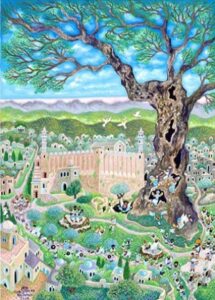בס”ד
By Rabbi Moshe Goodman, Kollel Ohr Shlomo, Hebron

This parsha describes the burial of Yakov at Maarat Hamachpela. We see seven hasidim “within” the large
tree, seven to the far left [all in same garb with brown caps], and seven on a rock/stump. The hasidim in
the tree play musical instruments. Three are blowing trumpets, one is playing the tambourine. Trumpets in
the Zohar are associated to the sefirot netzach and hod, and the Arizal teaches that also yesod is
considered to be a continuation of netzach and hod (E”H Rafach, ch. 4). Therefore, the hasidim playing
trumpets seem to correspond to netzach, hod, and yesod. The hasid playing the tambourine, a rhythm
instrument, seems to correspond to malchut, associated with rhythm. The hasid with the blue cap,
sounding the shofar, meant to arouse kindness and mercy on Rosh Hashana, seems to correspond to
hesed-kindness which is also associated to blue, which the Kabbalists tie to Hochma of the “right side of
kindness.” Opposite this hasid is a hasid with a red cap, a color associated with gevura. Between them
there is a hasid with a red cap, but that is carrying two blue/white flags by his right and left arms, seeming
thus to “bridge” between the right and left, between blue and red, an attribute typical of the sefira tiferet.
It could be that the reason these figures are “upside down” from a Kabbalistic perspective, is because they
are found here in reference to a tree, which is also “upside down” in a sense, since the trunk of the tree is
its “source,” while its branches in the sky are actually the “outcome” of the trunk. Spiritually speaking,
the “outcome” is always seen as “below” the “source”. Note also the three white “angelic” doves above
the Maara building. These may hint to the three Patriarchs of “angelic”-saintly status.
Here we would like to shift our discussion to the current war in Gaza, which is part of the Land of Israel.
There is a special connection between Hebron, depicted in this painting, and Gaza. One connection is
found in Avraham Avinu’s move from Hebron to the “land of the Philistines,” of which Gaza was a
leading part. Also, we know that Shimshon drew the gates of Gaza from Gaza to Hebron. Gaza in Hebrew
is “Aza,” a derivative from the word “oz” – might and courage. It could be that the connection between
Hebron and Aza comes to show that through the might and courage of Hebron, as Kaleb drew to fight the
scheme of the spies, we can also draw might and courage to conquer and re-settle Gaza.



